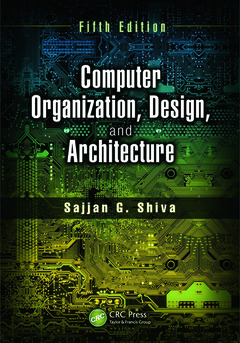Computer Organization, Design, and Architecture, Fifth Edition (5th Ed.)
Auteur : Shiva Sajjan G.

Suitable for a one- or two-semester undergraduate or beginning graduate course in computer science and computer engineering, Computer Organization, Design, and Architecture, Fifth Edition presents the operating principles, capabilities, and limitations of digital computers to enable the development of complex yet efficient systems. With 11 new sections and four revised sections, this edition takes students through a solid, up-to-date exploration of single- and multiple-processor systems, embedded architectures, and performance evaluation.
See What?s New in the Fifth Edition
- Expanded coverage of embedded systems, mobile processors, and cloud computing
- Material for the "Architecture and Organization" part of the 2013 IEEE/ACM Draft Curricula for Computer Science and Engineering
- Updated commercial machine architecture examples
The backbone of the book is a description of the complete design of a simple but complete hypothetical computer. The author then details the architectural features of contemporary computer systems (selected from Intel, MIPS, ARM, Motorola, Cray and various microcontrollers, etc.) as enhancements to the structure of the simple computer. He also introduces performance enhancements and advanced architectures including networks, distributed systems, GRIDs, and cloud computing.
Computer organization deals with providing just enough details on the operation of the computer system for sophisticated users and programmers. Often, books on digital systems? architecture fall into four categories: logic design, computer organization, hardware design, and system architecture. This book captures the important attributes of these four categories to present a comprehensive text that includes pertinent hardware, software, and system aspects.
Introduction. Number Systems and Codes. Combinational Logic. Synchronous Sequential Circuits. A Simple Computer: Organization and Programming. A Simple Computer: Hardware Design. Input/Output. Processor and Instruction Set Architectures. Memory and Storage. Arithmetic/Logic Unit Enhancement. Control Unit Enhancement. Advanced Architectures. Embedded Systems. Mobile Processors. Computer Networks and Distributed Processing. Performance Evaluation. Appendices. Index.
Date de parution : 01-2014
17.8x25.4 cm
Thème de Computer Organization, Design, and Architecture, Fifth... :
Mots-clés :
Address Space; 2s Complement; Computer System Organization; L2 Cache; Number Systems and Codes; Execution Resources; Combinational Logic; Execution Time; Synchronous Sequential Circuits; Cycle Time; Program Loading; Cached Block; Full Adder; Cache Line; Segment Registers; Indexing R1; Clock Pulses; Data Word; Cpu Register; DEC PDP-1; Instruction Fetch; MCU; Parity Bit; Instruction Cache; Address Bus; Data Bus; Sop Form; Raid Level; Pentium Ii; MIMD System



